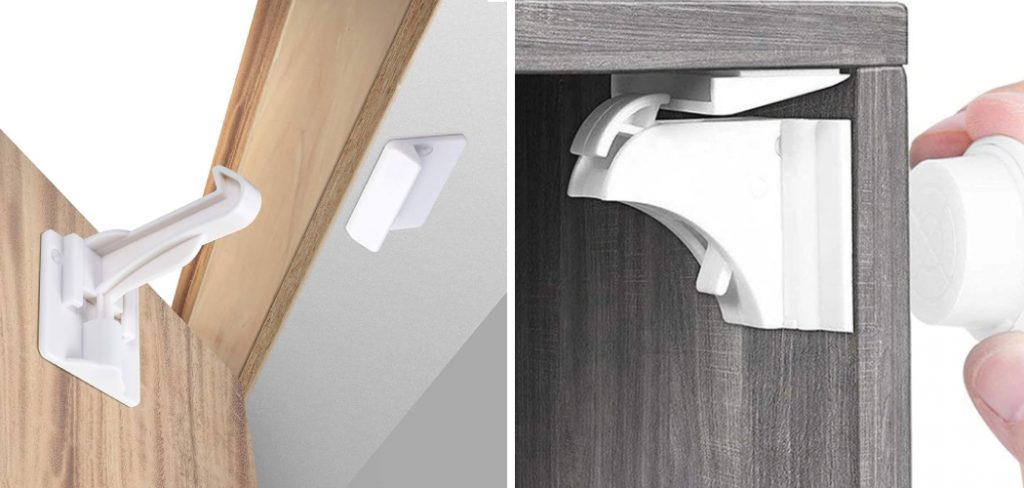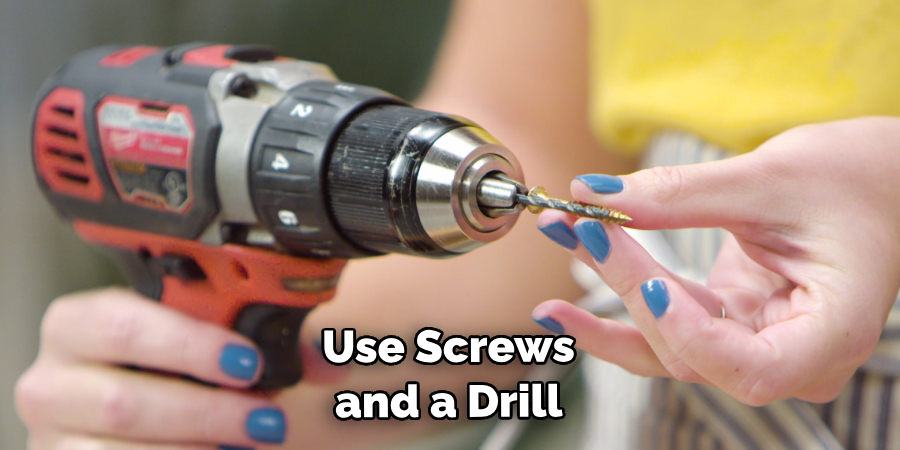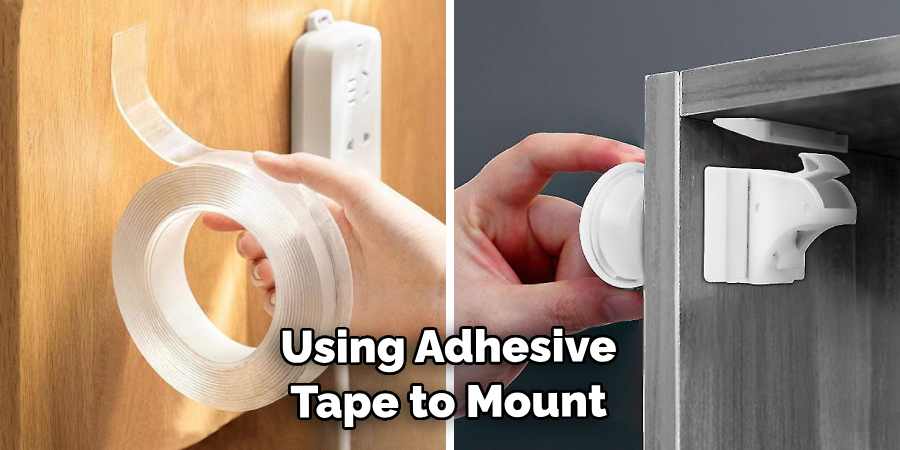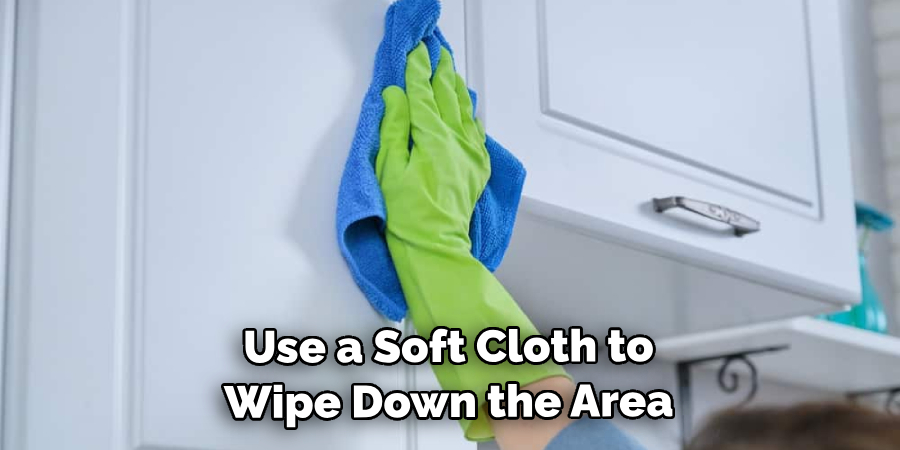Are you looking for a secure and easy way to keep your belongings safe from prying eyes? Drilling new locks into a cabinet may seem daunting, but it doesn’t have to be. With the right supplies and know-how, anyone can turn an ordinary cabinet into an impenetrable fortress with ease.

In this blog post on how to lock a cabinet without drilling, we’ll walk you through how to lock your cabinets without drilling – so you can rest assured knowing no one will ever get their hands on your precious personal possessions!
Needed Materials
Given below are some of the materials and tools that you’ll need to lock a cabinet without drilling:
- Cabinet Locks
- Adhesive Tape
- Screwdriver or Drill Bits (Optional)
- Hammer (Optional)
11 Step-by-step Guidelines on How to Lock a Cabinet Without Drilling
Step 1: Prepare the Cabinet
First, you’ll need to prepare your cabinet for installation. Measure and mark the areas where the lock will be installed and make sure everything is level. It’s important to make sure the locks are properly aligned when installing them to ensure a secure fit. This step is especially important if you are using adhesive tape to install the locks. It’s also a good idea to clean the area before installation.
Step 2: Install Lock Hardware
Attach the lock hardware to its respective area on the cabinet with adhesive tape. Make sure it’s firmly secured so that it won’t come loose in the future. You can also choose to use screws and a drill for this step if desired. It’s important to make sure the lock hardware is firmly secured before moving on to the next step. But, if you are using adhesive tape to mount the lock hardware, make sure it’s completely dry before moving on.

Step 3: Install Lock Plate
Once the lock hardware is installed, you’ll need to install the lock plate on the other side of the cabinet. Line up and attach it using adhesive tape or screwdriver/drill bits (optional). It’s important to make sure the lock plate is properly aligned with the lock hardware before moving forward. But, if you are using adhesive tape to mount the lock plate, make sure it’s completely dry before moving on.
Step 4: Secure Lock into Cabinet
Using a hammer (optional), tap the lock into place and make sure it’s locked in securely. This step is especially important if you are using adhesive tape to mount the lock. Make sure it’s securely secured before moving on. It’s also a good idea to test the lock and make sure it’s working properly.
Step 5: Test the Lock
Now that you’ve installed your cabinet lock, test it out to make sure everything is working properly. Try to open and close the door a few times with the key to ensure that it’s functioning as expected. You can also try to open it without the key to make sure that the lock is properly engaged. It’s important to make sure the lock is secure and functioning properly before moving on.
Step 6: Install Keyhole Cover
Once the lock is in place, attach a keyhole cover to the outside of your cabinet. This helps keep dust and other debris from entering the lock itself. But, it’s important to make sure the keyhole cover is fully secured and there are no gaps or openings that can allow dust or other debris into the lock. This is especially important if you are using adhesive tape to mount the keyhole cover.

Step 7: Insert the Key into the Lock
Insert your key into the lock and turn it a few times to make sure it’s working correctly. If you are using a combination lock, make sure to test the combination several times to ensure that it’s functioning properly. It’s important to make sure the lock is working properly before moving on. But, if you are using a keyed lock, make sure the key is securely inserted into the lock so that it won’t come out easily.
Step 8: Close the Cabinet Door
Now that your lock is installed, you can close the cabinet door and make sure it’s securely locked. It’s important to make sure the lock is engaged and that the door is securely locked before moving on. It’s also a good idea to test the lock again and make sure it’s still working properly. Although, if you are using adhesive tape to mount the lock it is important to make sure that it’s completely dry before closing the door
Step 9: Test out the Lock Again
After closing the door, test out the lock one more time to double-check that everything is in order. It’s important to make sure the lock is securely locked and that it won’t open easily. This is especially important if you are using a combination lock, as any incorrect numbers can cause the lock to malfunction. You can also try to open the cabinet door without using the key or combination to make sure it’s securely locked.
Step 10: Remove Adhesive Tape
Once you’re sure the lock is functioning properly, remove any remaining adhesive tape and discard it. You don’t want any leftover adhesive tape on your cabinet, as it can be a potential hazard.
It’s best to remove the tape and discard it properly. But don’t forget to use a soft cloth to wipe down the area and make sure it’s free of any remaining debris or dirt. However, if you are using screws to mount the lock hardware and the lock plate, leave them in place for added security.

Step 11: Enjoy Your Secure Cabinet
And that’s it! You’ve now successfully locked your cabinet without drilling – enjoy your newfound peace of mind knowing that your belongings are safe and secure. Always make sure to keep your key and combination safe so that no one can access your cabinet without your permission.
It’s also a good idea to check the lock every once in a while to make sure it’s still working properly. With just a few simple steps, you can easily keep your belongings safe and sound – no drilling required!
Following these steps on how to lock a cabinet without drilling, you can now easily create a secure cabinet without the need for drilling. Keep in mind that there are many other methods to lock a cabinet – but this method is one of the easiest and most hassle-free ways, allowing for a quick and easy installation with minimal effort. With the right materials and know-how, anyone can securely lock their cabinets in no time.
Frequently Asked Questions
Q: What Kind of Locks Are Best for Cabinets?
A: The best type of lock for a cabinet depends on your security needs and budget. Generally, barrel locks are the most common and affordable option. However, if you’re looking for more robust protection, combination locks or keyless entry systems may be better suited to your needs.
Q: Can I Install My Own Locks?
A: Yes, you can easily install your own locks without the need for drilling. As long as you have the right tools and supplies, anyone can do it in a matter of minutes! It’s a great way to add extra security and peace of mind without the hassle of having to hire a locksmith.
Q: How Do I Maintain My Cabinet Lock?
A: To ensure that your lock continues to function properly, it’s important to keep it clean and in good condition. Be sure to regularly check for any signs of wear or damage, and replace the locks when necessary. Additionally, you can use a lubricant to keep the locks moving smoothly.
Q: What Should I Do If My Lock Gets Stuck?
A: If your lock gets stuck, try using a lubricant to loosen it up. You may also need to gently tap the back of the lock with a hammer or screwdriver (if necessary). If neither of these solutions works, it’s best to call an expert locksmith for further assistance.

Conclusion
In order to successfully lock a cabinet without drilling, it is important to remember a few key considerations. Before attempting any kind of locking mechanism, you should think carefully about what kind of door, materials and security level is needed for your needs. Additionally, it’s important to ensure the mechanism and the door match so that the door can be opened properly once installed using whatever method you decide on.
Lastly, after you have made all these decisions, you can choose either a magnetic lock or a friction latch depending on the situation best suited for your cabinet needs. Now that you know how to lock a cabinet without drilling, why not go ahead and secure those cabinets today? You’ll be glad you did!
About
Safety Fic is a distinguished figure in the world of Diy design, with a decade of expertise creating innovative and sustainable Diy solutions. His professional focus lies in merging traditional craftsmanship with modern manufacturing techniques, fostering designs that are both practical and environmentally conscious. As the author of diy, Safety Fic delves into the art and science of Safety Fic-making, inspiring artisans and industry professionals alike.
Education RMIT University
(Melbourne, Australia) Associate Degree in Design (Safety Fic) Focus on sustainable design, industry-driven projects, and practical craftsmanship. Gained hands-on experience with traditional and digital manufacturing tools, such as CAD and CNC software.
Nottingham Trent University
(United Kingdom) Bachelor’s in diyfastly.com and Product Design (Honors) Specialized in product design with a focus on blending creativity with production techniques. Participated in industry projects, working with companies like John Lewis and Vitsoe to gain real-world insights.
Publications and Impact
In diy, Safety Fic his insights on indoor design processes, materials, and strategies for efficient production. His writing bridges the gap between artisan knowledge and modern industry needs, making it a must-read for both budding designers and seasoned professionals.
